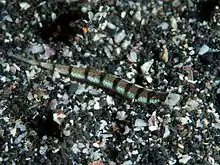Limnichthys fasciatus
Limnichthys fasciatus, the barred sand burrower, is a species of sandburrower. It is noted for its highly developed eyes, with a structure similar to the eyes of a chameleon, which has led it to be described as marine chameleon.[2] Its fully grown length measures between 20 millimetres (0.79 in) and 40 millimetres (1.6 in). The species is native to reefs in the Indo-Pacific. The fish preys on plankton prey by surprise attacking it from a hiding in loose sand,[3] with only the eyes protruding from the sand.[4][5]
| Barred sand burrower | |
|---|---|
 | |
| Scientific classification | |
| Kingdom: | Animalia |
| Phylum: | Chordata |
| Class: | Actinopterygii |
| Order: | Trachiniformes |
| Family: | Creediidae |
| Genus: | Limnichthys |
| Species: | L. fasciatus |
| Binomial name | |
| Limnichthys fasciatus Waite, 1904 | |
Vision
A unique property of this species is its vision. The cornea is 1/7th of the thickness of the entire eye, and has a convex shape due to a lens embedded in the cornea.[6] The cornea can focus, which allows the fish to have depth perception without moving its head. The lens itself is flattened.[2] Its eye is also notable for its high density of retinal ganglion cells compared to other species of fish.[5] Because of the rapid and accurate attack on prey, it is assumed the fish has good eyesight.
References
- "Limnichthys fasciatus (Barred Sand Burrower)". IUCN Red List of Threatened Species.
- Pettigrew, J. D., and S. P. Collin. "Terrestrial optics in an aquatic eye: The sandlance, Limnichthytes fasciatus (Creediidae, Teleostei)." Journal of Comparative Physiology A 177.4 (1995): 397–408.
- Schwab, I. R., S. P. Collin, and J. D. Pettigrew. "Chameleon of the sea." British Journal of Ophthalmology 89.1 (2005): 4–4.
- Fritsches, Kerstin A., and Justin Marshall. "A new category of eye movements in a small fish." Current Biology 9.8 (1999): R272–R273.
- Ivan R. Schwab; Richard R. Dubielzig; Charles Schobert (5 January 2012). Evolution's Witness: How Eyes Evolved. OUP USA. p. 106. ISBN 978-0-19-536974-8.
- Johan Rinder (1940). Acta Physiologica Scandinavica: Supplementum. publisher not identified. p. 8.
